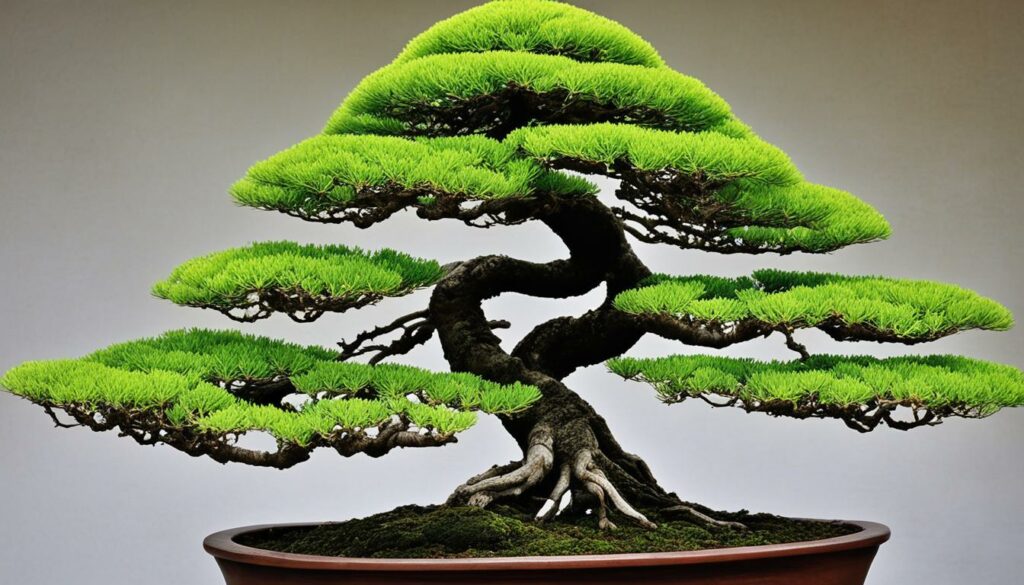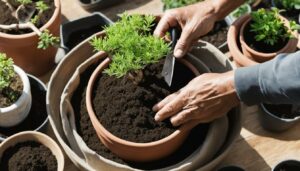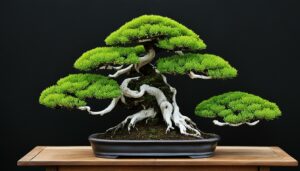For centuries, the art of bonsai cultivation has been admired around the world for its elegance, grace, and beauty. At the heart of this ancient Japanese practice lies the development of the trunk and branch structure, which is crucial in achieving a perfectly sculpted bonsai tree. In this article, you will learn everything you need to know to master bonsai cultivation and develop the ideal trunk and branch structure for your trees.
Key Takeaways:
- Developing the trunk and branch structure is essential for creating a visually appealing bonsai tree.
- Effective pruning and wiring techniques can be used to shape and guide the growth of your bonsai’s trunk and branches.
- The proper placement and positioning of branches is critical for achieving balance, harmony, and visual interest in your bonsai tree.
- Maintaining the trunk and branch structure of your bonsai requires proper watering, fertilizing, and repotting.
- Mastery of trunk and branch techniques is crucial to achieving the perfect bonsai tree.
The Fundamentals of Bonsai Trunk Development
Developing a strong and aesthetically pleasing trunk is a fundamental aspect of bonsai cultivation. The trunk serves as the foundation upon which the rest of the tree is built, anchoring the branches and conveying a sense of maturity and strength. Here are a few key principles and techniques to keep in mind when developing your bonsai trunk:
| Technique | Description |
|---|---|
| Pruning | Regular pruning helps shape the trunk and promote the growth of new branches, enhancing the overall structure of the bonsai. |
| Wiring | Wiring is an effective technique for guiding the trunk’s growth and creating bends, leading to a more dynamic and visually interesting tree. |
| Choosing the right style | The selection of the right bonsai style for the desired tree form is crucial in achieving the perfect trunk. Each style has different requirements and emphasis concerning the trunk development and overall tree shape. |
Other techniques, such as jin and shari, can be used to mimic the appearance of age and add character to the trunk. Keep in mind that trunk development is a gradual process that requires patience and attention to detail. By implementing these techniques and carefully monitoring the growth of your bonsai trunk, you can achieve a stunning and mature-looking tree.
Choosing the Right Bonsai Style for Trunk Development
When it comes to selecting the perfect bonsai style, it’s essential to consider how each style will affect the trunk development and overall tree form. Different styles emphasize various aspects of the tree, such as its branching pattern, leaf size, and overall proportion. Choosing the right style will help you achieve a well-balanced and aesthetically pleasing tree.
Formal Upright Style
The formal upright style is a popular option that emphasizes a straight, upright trunk with well-spaced branches positioned in a tiered manner. This style is excellent for showcasing a tree’s trunk development, making it a great choice if trunk development is your primary goal.
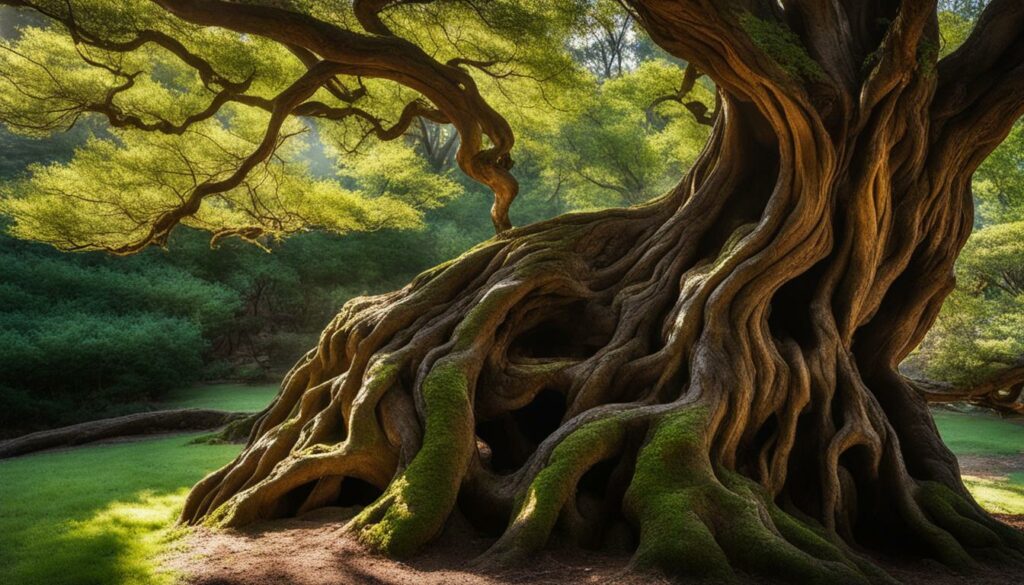
Informal Upright Style
The informal upright style is a more relaxed option that emphasizes the tree’s natural growth habit, creating a gentle curve in the trunk. The branches are still well-placed but are more irregularly positioned than those in the formal upright style, creating a more natural-looking tree.
Slanting Style
The slanting style is a dynamic option that emphasizes a tree’s movement and direction. In this style, the trunk is slanted to the side, creating a sense of movement. The branches are well-placed and elongated, adding to the overall sense of energy and vitality of the tree.
Cascade Style
The cascade style is a dramatic option that emphasizes a tree’s vertical movement. In this style, the trunk and branches extend downward, mimicking a tree growing off a cliff or steep slope. This style is excellent for highlighting a bonsai’s branch structure while creating a sense of drama and intrigue.
“Choosing the right bonsai style can make all the difference in achieving trunk development and overall tree form that is both striking and balanced.”
Pruning Techniques for Trunk Development
Pruning is a crucial technique in bonsai cultivation that helps shape the trunk, enhance the taper, and create movement in your tree. When pruning your bonsai, keep in mind the overall design you’re aiming for, the species of your tree, and the growth patterns of its branches. Here are a few tips to help you prune your bonsai for optimal trunk development:
Create a Plan
Before pruning your bonsai tree, take time to analyze its growth patterns and decide what needs to be trimmed. Plan your cuts carefully to maintain the natural flow and movement of the tree. Remove branches that are not contributing to the overall design and focus on retaining those that enhance the tree’s aesthetics.
Choose the Right Tools
Using proper tools is essential when pruning your bonsai. Sharp and precise pruning shears and saws will make clean cuts that will heal quickly and reduce damage to the tree. For thicker branches, use concave cutters to avoid unsightly scars. Remember to disinfect your tools before and after use to prevent the spread of disease.
Prune in Stages
Don’t rush when pruning your bonsai. Start with small cuts and never remove more than one-third of the foliage at once. Observe how your tree grows after each cut and adjust your technique accordingly. Remember that pruning stimulates new growth, so avoid over-pruning, since this can result in a weakened tree.
Target Unwanted Growth First
When pruning, target unwanted growth first. Start with dead and diseased branches, followed by crossing and rubbing branches. Trim back any branches that are growing straight up or down, and those that are growing on the inside of the curve.
Balance the Shape
When shaping your trunk, ensure that there is balance between the upper and lower parts of the tree. Avoid creating a bottle-shaped tree, where the trunk is much larger at the base than at the top. Instead, aim for a balanced, tapered trunk with gradual and smooth transitions between the different sections of the tree.
Wiring for Trunk Development
In bonsai cultivation, wiring techniques are often used to guide the growth of the trunk and create bends in order to enhance the overall structure of the bonsai. By wrapping wire around the trunk and branches of the tree, you can gently control their growth and shape them into the desired form.
When using wiring techniques, it’s important to use the correct gauge and material of wire for the specific tree species and size. Generally, aluminum wire is preferred over copper wire as it is easier to work with and less likely to damage the tree.
Steps for Wiring Your Bonsai Tree
Here are the steps for wiring your bonsai tree:
- Carefully select the areas of the trunk and branches that need shaping.
- Choose the appropriate gauge wire for the job.
- Wrap the wire around the trunk or branch in a spiral motion, starting at the thicker end and finishing at the thinner end of the section being wired.
- Mold the wire to the desired shape and secure it in place with wire cutters.
- Check the wired area regularly to ensure there is no constriction or damage to the tree.
- Remove the wire once the desired shape has been achieved. Be careful not to damage the tree in the process.
Remember that wiring should be done carefully and only when necessary, as it can cause stress to the tree if done improperly or left on for too long. By using proper wiring techniques, you can achieve a beautiful, well-structured bonsai tree with a strong and aesthetically pleasing trunk.
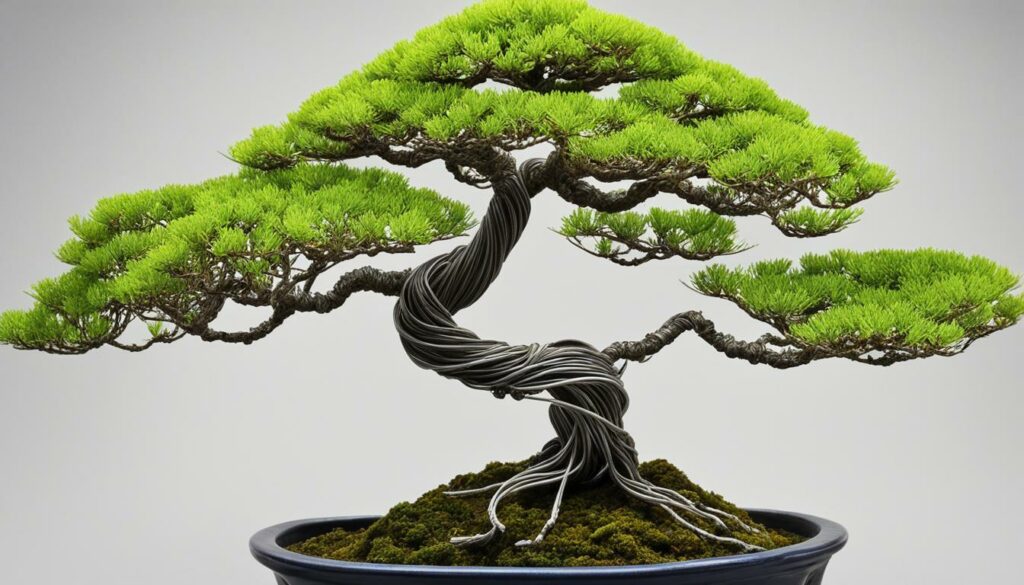
Understanding Bonsai Branch Structure
Proper branch structure is crucial to creating a stunning bonsai tree. Each branch must be chosen and positioned carefully to enhance the overall aesthetic appeal, and the branches must also be positioned to increase the tree’s balance and harmony. The branch structure of a bonsai must also be in line with the overall tree form.
To achieve optimal branch structure, it is essential that you have a clear understanding of how to shape each branch properly. It is recommended that you start cultivating branches from the lowest ones on the tree towards the top, ensuring that they are evenly spaced.
Bonsai shaping techniques for branch structure include regular pruning and wiring to prevent the branches from growing in an uncontrolled manner. By using pruners to cut back new growth regularly, you’ll encourage more compact branching and create a more refined shape. Regular wiring will also guide your branches into your chosen direction, creating more visually appealing styles.
One technique that can help create exceptionally beautiful branching patterns in a bonsai tree is the concept of ramification. Ramification refers to when multiple, fine branches grow from the same point on a tree, creating a more intricate design.
To help you better understand branch structure in bonsai trees, let’s take a closer look at the branch structure of the Japanese maple.
Japanese Maple Branch Structure
| Branches | Position | Size | Angle |
|---|---|---|---|
| Sacrificial Branches | Lower sections of the trunk | Larger than secondary branches | Upward |
| Secondary Branches | Middle sections of the trunk | Smaller than sacrificial branches, larger than tertiary branches | Alternating or opposite angles from the trunk |
| Tertiary Branches | Upper sections of the trunk | Smallest branches on the tree | Alternating or opposite angles from the secondary branches |
Understanding branch structure is vital to creating a truly breathtaking bonsai tree. Take the time to understand the key principles of bonsai shaping and invest in the right tools, and you’ll be on your way to creating a work of living art that will bring joy to your life for years to come.
Branch Placement and Direction
Branch placement and direction are crucial in achieving a beautiful and balanced bonsai tree. The correct positioning of branches can create a sense of harmony and balance, whereas improper placement can result in an unappealing and disordered appearance.
You should position branches in a way that enhances the bonsai’s branch structure and tree form. One useful technique is to utilize negative space, leaving areas open between branches to allow light to penetrate and improve overall health. Avoid crowding branches or placing them too uniformly, which can create a monotonous appearance.
When choosing the direction of branches, consider the tree’s natural growth patterns and select a direction that complements them. Use wiring to guide branches in the desired direction to create a visually pleasing and natural shape.
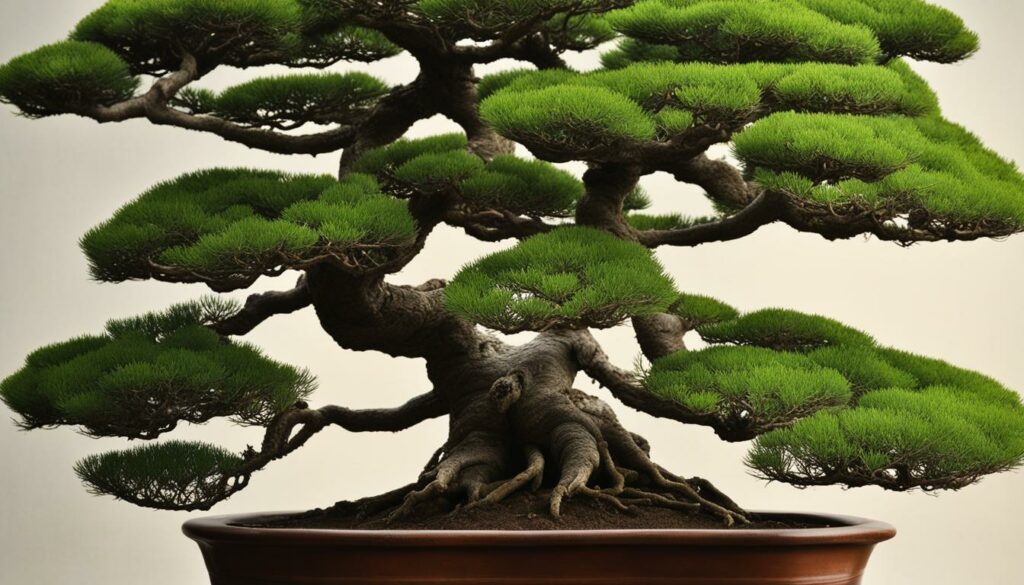
It’s essential to be patient when positioning branches, as it can take time to achieve the perfect placement and direction. However, careful attention to details like placement and direction will ultimately result in a stunning and harmonious bonsai tree.
Pruning and Wiring for Branch Development
Branch development is a critical aspect of bonsai shaping and contributes greatly to the overall aesthetics of the tree. Pruning and wiring are fundamental techniques that are used to guide and promote growth, create movement, and achieve the desired shape and form in your bonsai tree.
Pruning:
Pruning is the process of trimming the branches of a tree to shape it or maintain its health. In bonsai cultivation, pruning is used to create the desired branch structure, enhance taper, and control the overall shape and size of the tree. Proper pruning techniques involve cutting the branches at the right angle and distance, depending on the age and thickness of the branch.
Wiring:
Wiring is used to guide the growth of the branches and shape them in a desired direction. In bonsai cultivation, copper or aluminum wires are wrapped around the branches and trunk of the tree to create bends and angles that simulate the effects of the natural environment on tree growth. The wires are removed once the branches have set in place, usually after several months or a year.
When pruning and wiring for branch development, it is important to consider the placement and direction of the branches to achieve balance and harmony in your bonsai tree. Keep in mind that these techniques should be done at the right time of the year, depending on the species of the tree, to avoid harming its overall health and growth.
Branch Ramification Techniques
As your bonsai tree matures, the cultivation of fine branching and ramification becomes essential in achieving a refined and intricate appearance. Branch ramification refers to creating a network of secondary and tertiary branches that emerge from the primary ones.
One of the most effective techniques for promoting branch ramification is defoliation, a process in which all leaves are removed from a branch. This stimulates dormant buds to sprout, resulting in new, more compact branches. However, defoliation should be done selectively and in moderation to avoid damaging the tree’s overall health.
Another technique is called “clip and grow,” which involves pruning back new growth to encourage more branching. As the new shoots grow, they are repeatedly clipped, causing ramification to occur. This technique is particularly useful for creating the shape of the bonsai tree, but again, it should be done with care to avoid excessive damage.
For more advanced branch ramification, you can use thinning techniques. This process involves selectively removing weaker branches to encourage the growth of stronger ones. Over time, this results in a more refined and detailed branching structure, transforming your bonsai tree into a true masterpiece.
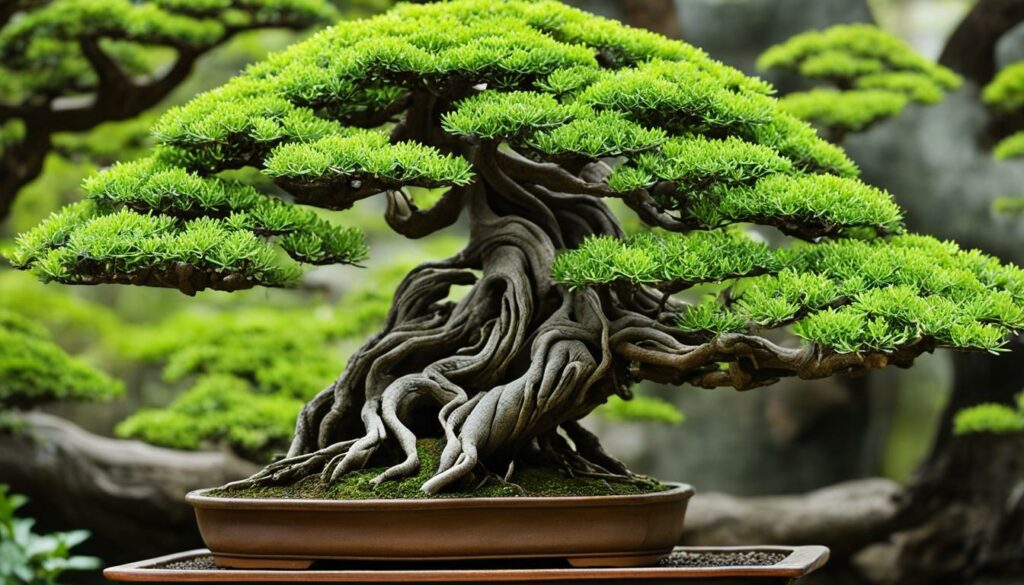
The Benefits of Branch Ramification
Not only does branch ramification add depth and refinement to the appearance of your bonsai tree, but it is also essential in creating a healthy and robust tree. By promoting branching and increasing foliage, you are aiding in the tree’s photosynthesis process, which ultimately helps it to grow stronger and live longer.
Bonsai Styling: Modern Trends and Traditional Approaches
There is no one-size-fits-all approach to bonsai styling, making it an art form that allows for personal creativity and experimentation. Traditional Japanese styles, such as formal upright (chokkan) and slanting (shakan), emphasize natural growth patterns and proportions, while modern approaches, like the broom style (hokidachi), veer away from traditional shapes and embrace unique forms.
The styling approach you choose will greatly impact the development of both the trunk and branch structure in your bonsai. For instance, the cascade style (kengai) features a cascading trunk and branches, creating a unique growth pattern that requires special care and shaping techniques to maintain balance and prevent breakage. Similarly, the windswept style (fukinagashi) mimics trees growing on blustery mountain slopes, and requires strategic bending, wiring, and pruning to achieve the desired effect.
When styling your bonsai, consider the tree’s natural growth habits, the environment in which it will be displayed, and your personal aesthetic preferences. Take inspiration from both traditional and modern techniques, and experiment until you find a style that speaks to you and complements your vision for a beautiful and harmonious bonsai.
In the table below, we’ve outlined some common bonsai styles and their impact on trunk and branch development.
| Bonsai Style | Trunk and Branch Development |
|---|---|
| Formal Upright (Chokkan) | Emphasizes upright growth with a tapered trunk and evenly spaced branches. |
| Informal Upright (Moyogi) | Features an irregular trunk with various branch lengths and angles, mimicking natural tree growth. |
| Slanting (Shakan) | Trunk grows at a slanting angle with a gradual taper; branches are arranged in tiers. |
| Semi-Cascade (Han-Kengai) | Trunk grows at a slanting angle with a cascading branch structure; requires special care to prevent breakage. |
| Cascade (Kengai) | Trunk grows at a steep angle, cascading branches flow downwards; requires skillful pruning and wiring. |
| Broom (Hokidachi) | Features a straight, thick trunk with a broom-like branch structure growing straight outwards; requires strategic pruning and wiring. |
Table: Common Bonsai Styles and their Impact on Trunk and Branch Development.
Bonsai Training and Maintenance
Once you have developed the trunk and branch structure of your bonsai, it is essential to maintain it properly to preserve its shape and form. Here are some important tips and best practices for trunk development, branch structure, and bonsai shaping:
Watering
Proper watering is crucial for maintaining the health and growth of your bonsai tree. Water your bonsai when the soil starts to feel dry, but make sure not to overwater it as this can lead to root rot. Use a watering can to ensure a gentle flow of water all around the soil, avoiding spraying directly on the leaves and branches.
Fertilizing
Fertilizers play a vital role in providing the necessary nutrients for the growth and development of your bonsai tree. Use organic fertilizers rich in nitrogen, phosphorus, and potassium to promote healthy foliage, strong roots, and overall tree vigor. Apply fertilizer in early spring and early autumn, following the manufacturer’s instructions regarding the dosage and frequency of application.
Repotting
Repotting is essential to maintain the proper growth and health of your bonsai tree. As the tree grows, it will eventually outgrow its pot, restricting its root growth and leading to stunted development. Repot your bonsai every two to three years using well-draining soil, trimming the roots to maintain their size and shape.
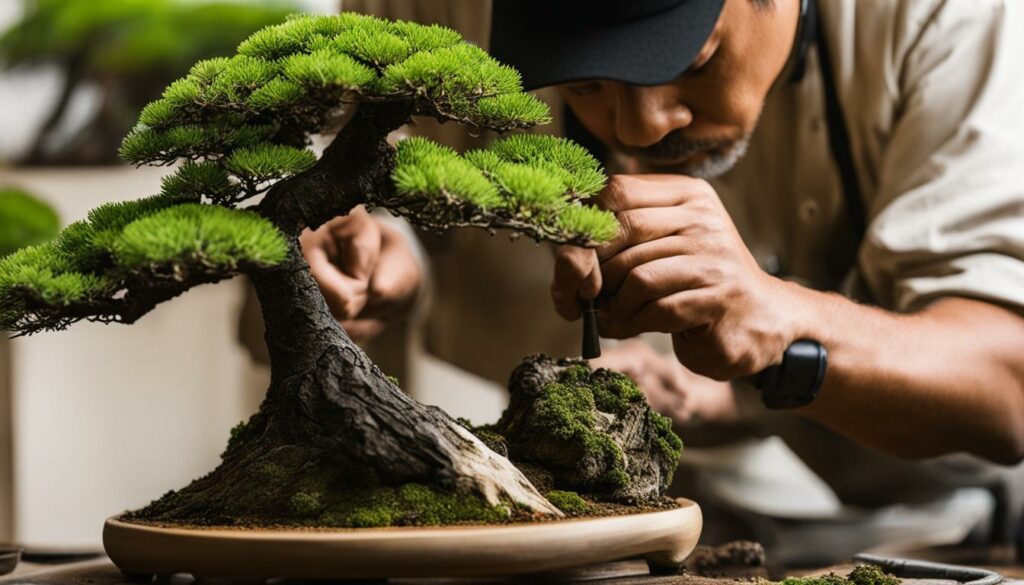
Regular pruning, wiring, and fertilizing will help you maintain the trunk development, branch structure, and bonsai shaping of your tree. By nurturing your bonsai with proper care and maintenance, you can ensure that it will continue to thrive and bring you joy for years to come.
Bonsai Display and Presentation
After dedicating hours of labor to develop the perfect trunk and branch structure, it’s time to showcase your bonsai using suitable presentation techniques. Aesthetically pleasing pots and stands can enhance the appeal of your bonsai, emphasizing its form and structure. Here are some tips to highlight your bonsai’s features:
- Choose a pot that complements the shape and color of your bonsai, making sure it’s appropriately sized.
- Consider the height of the stand. A taller stand can accentuate the tree’s height, while a shorter stand can highlight its width.
- Use moss to cover the soil and create a naturalistic effect.
- Place the bonsai in a location that has access to natural light but is not exposed to direct sunlight or adverse weather conditions.
Remember that a well-displayed bonsai can complement the surrounding décor and create a serene and calming atmosphere. Make your Bonsai the center of attention in any room by giving it the suitable presentation that it deserves.
Analysis of Bonsai Cultivation: Common Challenges and Solutions
Bonsai cultivation requires patience, dedication, and a steadfast commitment to developing and shaping the trunk and branch structure of your tree. However, despite your best efforts, you may encounter common challenges in the process. Here, we’ll address these challenges and provide practical solutions to help you overcome them and achieve your goals for your bonsai tree.
Challenge: Slow Trunk Development
The development of the trunk is crucial for creating a strong and aesthetically pleasing bonsai tree, but it can be a slow process that requires time and patience. If you’re experiencing slow trunk development, there are a few things you can do to encourage growth:
- Ensure your bonsai is getting enough sunlight and water
- Use fertilizer specifically designed for bonsai trees
- Consider repotting your tree to refresh the soil and promote growth
| Challenge | Solution |
|---|---|
| Slow trunk development | Ensure adequate sunlight, water, and fertilizer. Consider repotting. |
| Irregular branch growth | Pinch or prune to redirect growth. Use wiring to control and guide growth. |
| Insect infestations | Regularly inspect and treat your bonsai tree using organic or chemical remedies. |
| Overwatering | Ensure proper drainage and reduce watering frequency. Repot if necessary. |
Challenge: Irregular Branch Growth
Branches that grow irregularly can throw off the balance and aesthetics of your bonsai tree. To address this, you can:
- Pinch or prune branches to redirect growth
- Use wiring techniques to control and guide the growth of branches
Challenge: Insect Infestations
While bonsai trees are generally resilient and resistant to pests, they can still fall victim to infestations. To prevent or address insect infestations, regularly inspect your bonsai tree and use organic or chemical remedies, including insect sprays and systemics.
Challenge: Overwatering
Overwatering can lead to root rot and other issues in bonsai trees. To avoid this, ensure that your tree has proper drainage and reduce your watering frequency. If necessary, repot your tree into fresh soil to help it recover.
By recognizing and addressing these common challenges, you can continue to cultivate and shape your bonsai tree’s trunk and branch structure with confidence and success.
Tools and Equipment for Bonsai Trunk and Branch Development
Developing a beautiful bonsai tree requires the right set of tools and equipment. Here are some of the essential tools needed for effective trunk and branch development:
Bonsai Pruning Shears
Pruning shears are one of the most important tools for bonsai trunk and branch development. They are used for precise pruning of branches and shoots, as well as trimming foliage and roots. Look for pruning shears with sharp blades and comfortable grips for ease of use.
Wire Cutters
Wire cutters are vital for shaping and guiding the growth of branches and trunks in bonsai trees. They are used to cut and remove wire that has been wrapped around a branch or trunk to manipulate its shape. Choose wire cutters that are sturdy and durable for long-lasting use.
Bonsai Wire
Bonsai wire is used to wrap around branches and trunks to shape them into desired forms. It is typically made of aluminum or copper, and comes in various thicknesses. Choose the right thickness of wire based on the size of the branch, as well as the desired shape and form.
Bonsai Turntable
A bonsai turntable is an excellent tool for working on your tree. It allows you to rotate the tree easily, providing better access to all angles of the trunk and branches for pruning and wiring. Look for a turntable with a non-slip surface to prevent the tree from sliding while working on it.
Bonsai Soil Mix
Choosing the right soil is essential for healthy bonsai trunk and branch development. Look for soil mixes that provide good drainage and aeration, while also retaining moisture. You can also add other components to the mix, such as sand, gravel, or perlite, for additional benefits.
Bonsai Fertilizer
A good bonsai fertilizer provides essential nutrients for the growth and development of your tree. Choose fertilizers with balanced ratios of nitrogen, phosphorus, and potassium, as well as micronutrients. Fertilize your bonsai regularly, following the manufacturer’s instructions for best results.
Investing in quality tools and equipment is crucial for effective trunk and branch development in bonsai cultivation. With the right set of tools, you’ll be able to shape and sculpt your bonsai tree into a work of living art.
Conclusion
Developing the trunk and branch structure is a crucial aspect of bonsai cultivation. By mastering the techniques discussed in this article, you can sculpt the perfect bonsai tree that is both aesthetically pleasing and healthy. Remember to choose the right bonsai style for your tree, use effective pruning and wiring techniques, and maintain the trunk and branch structure with proper training and maintenance.
To summarize, the key to successful bonsai cultivation is continuous learning and practice. By applying the principles and techniques of bonsai cultivation, you can create a work of living art that reflects your patience, creativity, and passion. Keep exploring, experimenting, and refining your skills in Bonsai Cultivation Developing Trunk and Branch Structure, and enjoy the journey towards creating beautiful bonsai trees.
FAQ
What are the key principles for developing the trunk in bonsai cultivation?
The key principles for developing the trunk in bonsai cultivation include proper pruning techniques to shape the trunk, enhance taper, and create movement. Wiring can also be used to guide the growth of the trunk and create bends. These techniques help to establish a strong and aesthetically pleasing trunk structure.
How does the choice of bonsai style impact trunk development?
The choice of bonsai style has a significant impact on trunk development. Each bonsai style has its own requirements and preferences for trunk characteristics. For example, formal upright styles emphasize a straight, upright trunk, while informal upright styles allow for some bends and curves. It’s important to choose a style that aligns with your desired trunk development goals.
What pruning techniques can be used for trunk development in bonsai?
Pruning techniques such as directional pruning, clip and grow, and selective pruning can be used for trunk development in bonsai. Directional pruning involves pruning branches in a specific direction to encourage the growth of the trunk. Clip and grow involves selectively pruning branches and allowing other branches to grow freely, shaping the trunk over time. Selective pruning is used to remove unwanted branches and promote the growth of desired branches for trunk development.
How does wiring contribute to trunk development in bonsai?
Wiring is a technique used in bonsai to guide the growth of the trunk and create bends. By carefully wrapping wire around the trunk and gently bending it, the trunk can be shaped and trained into the desired form. Wiring can enhance the overall structure of the bonsai and contribute to the development of a strong and visually pleasing trunk.
Why is branch structure important in bonsai cultivation?
The branch structure plays a crucial role in the overall aesthetics of a bonsai tree. It helps to create balance, harmony, and visual interest. Properly structured branches also contribute to the illusion of a mature tree. The branch structure should be carefully planned and maintained to ensure the desired tree form is achieved.
How can branches be strategically placed and positioned in bonsai?
When positioning branches in bonsai, it’s important to consider factors such as balance, visual interest, and overall tree form. Branches should be placed in a way that creates a sense of harmony and avoids overcrowding. They should also be oriented in a way that mimics the natural growth patterns of trees. Strategic branch placement and direction contribute to the overall beauty of the bonsai tree.
What techniques can be used for pruning and wiring branches in bonsai?
Pruning and wiring are effective techniques for branch development in bonsai. Pruning is used to selectively remove unwanted branches and encourage the growth of desired branches. Wiring can be used to guide the growth of branches, create movement, and enhance the overall structure of the bonsai. Pruning and wiring must be done carefully and with consideration for the desired shape and form of the bonsai.
How can branch ramification be achieved in bonsai?
Branch ramification refers to the development of fine branching and twigs in bonsai trees. Achieving branch ramification requires a combination of techniques such as selective pruning, pinching, and defoliation. By carefully managing growth and encouraging the growth of smaller branches, branch ramification can be achieved, adding depth and refinement to the overall appearance of the bonsai.
What are some popular bonsai styling approaches?
Bonsai styling can involve both modern trends and traditional approaches. Some popular styling approaches include formal upright, informal upright, slanting, cascade, and windswept styles, among others. Each style has its own characteristics and techniques for trunk and branch development, allowing for artistic expression and personalized interpretation in bonsai cultivation.
How can the trunk and branch structure be effectively maintained in bonsai?
To maintain the trunk and branch structure of a bonsai tree, proper watering, fertilizing, and repotting techniques must be practiced. Regular grooming, including pruning and wiring as needed, helps to promote healthy growth and maintain the desired shape and form of the bonsai. It’s important to stay attentive to the needs of the tree and provide the necessary care for its ongoing development.
How can I display my bonsai to highlight its trunk and branch structure?
Displaying your bonsai in suitable pots, stands, or in a garden can greatly enhance the visual impact of its trunk and branch structure. Choose pots or stands that complement the style and size of your bonsai. Consider using accent plants or moss to further accentuate the tree’s form. Experiment with different display techniques to showcase the beauty of your bonsai.
What are some common challenges in developing trunk and branch structure in bonsai?
Common challenges in developing trunk and branch structure in bonsai include achieving proper taper and avoiding reverse taper, preventing wire marks on the bark, and managing the growth of branches in densely ramified trees. These challenges can be addressed through careful planning, continuous observation, and adapting techniques to suit the specific needs of each bonsai tree.
What tools and equipment are essential for bonsai trunk and branch development?
Essential tools and equipment for bonsai trunk and branch development include pruning shears, concave cutters, wire cutters, wire, branch benders, and bonsai training pots. These tools help in shaping the trunk, pruning branches, and applying wiring techniques effectively. Investing in high-quality tools is essential for achieving desired results in bonsai cultivation.
